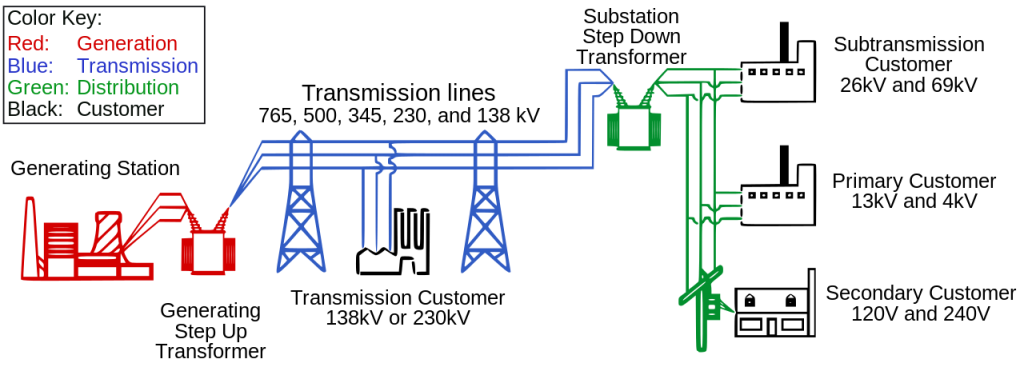
Image Credit: Ian Muttoo / CC BY-SA 2.0 / Flickr
Electricity markets around the world are transforming from a model where electricity flows one way (from electricity-generating power plants to the customer) to one where customers actively participate as providers of electric services. But to speed this transformation and maximize its environmental and cost benefits, we need to understand how customer actions affect the three distinct parts of our electric system: generation, transmission, and distribution.
Generation
Generators — or power plants — convert an energy source such as natural gas, coal, wind, or sunshine into electricity that flows across wires and into your building, allowing you to turn on lights and use appliances. Although the electricity is no different whether it is generated by solar or coal, the environmental and economic costs associated with different energy sources vary significantly.
Not all generators are created equal in terms of efficiency, pollution, and how much they cost to build and run. Some generators produce electricity very cheaply and with fewer carbon emissions, but are expensive to build and maintain. Other generators are more polluting than clean energy alternatives and cost more per unit (or kilowatt-hour) of electricity generated, but can be turned on when demand for electricity skyrockets (for example, during heat waves). As demand increases, a variety of generators are used to provide the needed electricity — relying first on the cheapest generators (such as wind and solar) in order to keep costs low, and only turning on expensive and inefficient “peaker” generators (such as natural gas-fired power plants) during periods of high demand.
Because higher demand for electricity from power plants drives up cost and pollution, reducing demand for power plant-generated electricity can reduce both the overall cost of the system and harmful environmental impacts.
Transmission
Electricity is transported from power plants to local communities via transmission lines. In addition to exporting energy from traditional power plants, transmission lines also allow communities to “import” clean and cheap energy from distant areas. But long transmission lines are expensive, and as more electricity flows through them, power is lost through heat, requiring greater amounts of electricity to be produced. Thus, different areas in the same state can face different prices for electricity depending on that area’s overall demand and distance from the generation sources.
Again, reducing demand and increasing local sources of generation helps control these transmission costs. The less electricity needed from large, distant power plants, the less electricity needs to be moved.
Distribution
Finally, local utility companies distribute electricity via the traditional electric wires we’re used to seeing on city streets. Some utility costs, such as billing and metering, are not affected by customers’ usage of electricity. However, very expensive grid infrastructure — including substations, transformers, wires, and poles — is significantly affected by how much electricity customers demand.
Local utilities also must conduct costly maintenance and operations on this infrastructure to avoid blackouts and meet safety requirements. Importantly, as local demand peaks, the system needs to expand accordingly, causing distribution costs to increase even further. For example, New York City’s local utility (Consolidated Edison) foresees a billion-dollar investment in a new substation to accommodate increased demand in the Brooklyn-Queens area.
Reducing demand for utility-provided electricity
Consider how residential rooftop solar affects the entire system. Each home equipped with solar panels requires less electricity from its local utility. Thanks to this reduction in demand and its related costs, the utility can use funding it would have needed for new transformers or substations to invest in improving energy efficiency or incentivizing more customers to generate their own electricity.
Consolidated Edison is currently pursuing this type of effort in the Brooklyn-Queens area by identifying multiple alternatives to try to avoid the billion dollar substation investment. Other utilities are also experimenting with home energy batteries, which can store excess solar energy during daylight hours for use at night, further reducing each customer’s daily electricity use and impact on the distribution system. And because solar reduces demand for utility-provided electricity, less electricity has to be generated at power plants and transmitted from distant regions, reducing generation, transmission, and environmental costs. Many initiatives across the country are attempting to capture the opportunities offered by these technologies to change the fundamental way we interact with the electric grid.

For example, the Reforming the Energy Vision (REV) initiative in New York and the Public Utilities Commission-mandated Distribution Resource Plans in California require utilities to consider alternatives to traditional infrastructure investments to deal with peak demand. These initiatives encourage customers to install rooftop solar or adopt energy efficiency, storage, and demand response to reduce their use of grid-supplied electricity at peak times.
And, in Texas, the Distributed Resource Energy and Ancillaries Market Task Force (DREAM TF) is working to guarantee that customers who generate electricity are able to actively participate in the Texas electricity market. This will ensure distributed energy resources are paid appropriately for the benefits they provide to the system.
These efforts in New York, California, and Texas are on the right track. Reducing the amount of electricity that needs to be generated by traditional power plants, transmitted long distances, and distributed locally, reduces the overall cost and environmental impact of our energy system. That’s not just clean, it’s smart.
Beia Spiller is a senior economist with the Environmental Defense Fund. Kristina Mohlin is an economist with the EDF. This blog post is part one in a four-part series that takes a deep dive into economics of the electric system and the role pricing can play in accelerating the clean energy economy. It originally appeared at the website of the Environmental Defense Fund.
Weekly Newsletter
Get building science and energy efficiency advice, plus special offers, in your inbox.















0 Comments
Log in or create an account to post a comment.
Sign up Log in